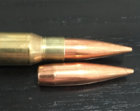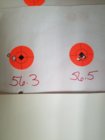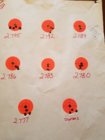Thx. I'll report back after the next trip to the range.
Well I'm not sure what I learnt from today. Except maybe I'm crap at shooting my 308.

I decided to try a seating depth test with 43.90 gr of Varget.
o 30 thou jump => 2.246” 4 rounds (3x loaded)
o 40 thou jump => 2.236” 4 rounds (3x loaded)
o 50 thou jump => 2.226” 5 rounds (2x loaded; 5 rounds to finish of 2x loaded brass)
o 60 thou jump => 2.216” 4 rounds (2x loaded)
o 70 thou jump => 2.206” 4 rounds (3x loaded)
o 80 thou jump => 2.196” 4 rounds (3x loaded)
With 50 thou jump I can clearly hear the powder in the case when shaking the cartridge. Not so by 70 thou jump.
Shot on Saturday 18 May 2019. Here's the data. Pic of target attached. Brass seems ok re excess pressure signs.
o 30 jump: 2607, 2594, 2601, 2573 Avg 2593.8 SD 14.82 ES 34. Group: W 0.42 MOA, H 0.60 MOA. Avg vel at target 2432, SD 11.3
o 40 jump: 2588, 2588, 2581, 2577 Avg 2583.5, SD 5.45, ES 11. Group: W 0.64 MOA, H 0.87 MOA. Avg vel at target 2430, SD 3.1
o 50 jump: 2576, 2599, 2595, 2587, 2606 Avg 2592.6, SD 11.55, ES 30. Group: W 0.30 MOA, H 0.79 MOA. Avg vel at target 2446, SD 9.9
o 60 jump: 2580, 2619, 2596, 2590 Avg 2596.3 SD 16.54 ES 39. Group: W 0.21 MOA, H 0.85 MOA. Avg vel at target 2448, SD 15.7
o 70 jump: 2604, 2586, 2608, 2621 Avg 2604.8 SD 14.45 ES 35. Group: W 0.49 MOA, H 0.6 MOA. Avg vel at target 2442, SD 11.0
o 80 jump: 2620, 2611, 2619, 2592 Avg 2610.8 SD 12.97 ES 28. Group: W 0.47 MOA, H 0.70 MOA. Avg vel at target 2458, SD 3.9
Best groups were 30 jump and 70 jump. (I knew I pulled one shot of the latter right.) Lowest velocity variance was from 40 jump. Previously I had done 3 shots at 43.90 and an estimated 58 jump (see post 1) and gotten very encouragingly low velocity variance. 60 jump today wasn't anywhere as encouraging.
Suggestions? I'm thinking a little more powder with 30 jump and maybe trying seating a little longer. Either that or just shooting my .223!!!!!
(Velocities recorded by the Two Box Chrono aren't comparable one day to the next due to box placement. The avg velocity at target from the Shotmarker should be however. As a reference, 43.90 gr of Varget at last outing was producing 2464 fps at 100 yd target.)














